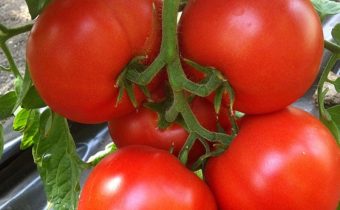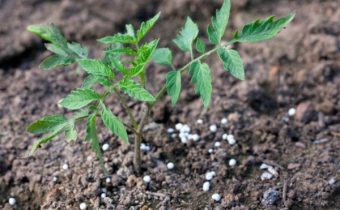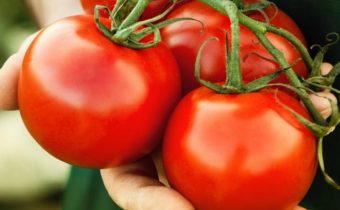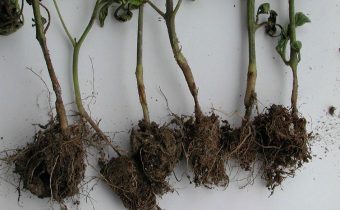Chinese way of growing tomato seedlings
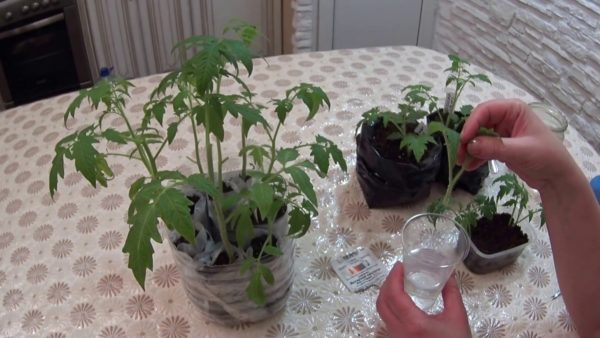
Features of the method
The essence of the method lies in the fact that the seedlings are sown earlier than a month. It draws out, which is absolutely natural. It is cut at the level of cotyledon leaves and rooted in the ground.
Doing such manipulations, the tomato plant undergoes severe stress, stops growing, spends additional time on rooting, but at the same time, the shoot becomes thicker, and the flower bunch is laid closer to the ground.
Since the planting was carried out earlier, the plant enters fruiting in that time period that is laid genetically, however, the grower seems that ripening begins earlier.
Advantages and disadvantages of the method
The Chinese method of growing seedlings of tomatoes has both advantages and disadvantages. Among the benefits are the following indicators:
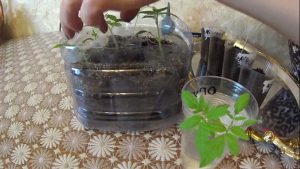
- seedlings grow lower and more compact;
- the whole plant form of an adult tomato bush, lower;
- no need to dive seedlings;
- increases the number of brushes.
Some growers indicate that tomato is becoming more resistant to diseases. In fact, sustainability is a genetically laid down trait and no “circumcision” can improve it.
Some argue that increases yields. This statement is also groundless, since everything depends on the variety and agrotechnology of cultivation.
The disadvantages of the method are the following:
- sowing takes place a month earlier than usual;
- the need for additional lighting of seedlings;
- the need for additional shelter to create a greenhouse effect;
- seedling survival rate of 75%.
Technological process
To understand the methodology of the work let us examine everything in order.
Sowing
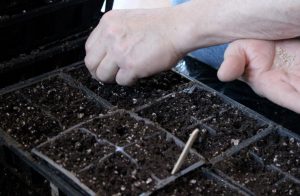 Tomato seedlings are grown using Chinese technology by sowing and picking, as well as normal, but the sowing time is postponed a month earlier.
Tomato seedlings are grown using Chinese technology by sowing and picking, as well as normal, but the sowing time is postponed a month earlier.
Since the moment of cutting off the shoot will stop growth, and it also takes time for rooting, in order to “catch up” with it, we sow earlier in the month.
We prepare seeds in the traditional way. If the seed is purchased and processed, then we sow dry, if not processed, then we warm it up. To do this, wrap the seed in a damp cloth and put it in a warm place. After 2-3 days, it is ready for sowing.
Seeding is done in pre-prepared or acquired soil. Having filled the tub, we compacted the earth, and on top lay out the spiked seeds with a distance of 5-6 cm. We cover it with an earthy mixture, moisten the surface with warm, soft (preferably snow, rain) water and close it with glass or film.
See also: We grow tomato seedlings for the greenhouse
Seedling care
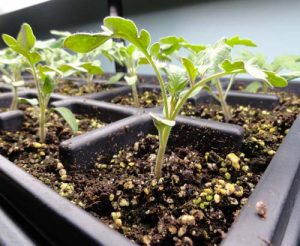 As soon as most of the seeds germinate, the temperature must be lowered.
As soon as most of the seeds germinate, the temperature must be lowered.
- In the afternoon - 16-18 ᵒC;
- At night - 12-14 ᵒC.
This temperature is maintained for 4-5 days.
With a decrease in temperature it is necessary to increase the illumination.Since planting a tomato according to the Chinese method implies a very early sowing, it is necessary to equip the place of cultivation with additional phyto lamps. Daily illumination for 2-3 hours in the morning and 2-3 hours in the evening will allow tomato plants to be more squat.
During this period, care consists of watering and maintaining the optimum temperature.
Picks
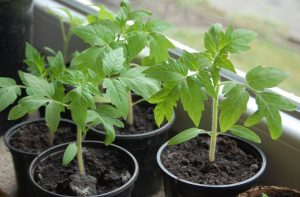 Planting a tomato in Chinese does not provide for a dive in the traditional concept of the word. Growing in one tub, the plant must grow to a height of 20 cm. During this period, there will be 3-4 pairs of true leaves and a pair of cotyledons on the shoot.
Planting a tomato in Chinese does not provide for a dive in the traditional concept of the word. Growing in one tub, the plant must grow to a height of 20 cm. During this period, there will be 3-4 pairs of true leaves and a pair of cotyledons on the shoot.
At this point, proceed to circumcision. Before cutting the shoots, the plants should be watered well, so that they have an optimal turgor of the foliage and the stem.
Preparing in advance:
- individual tanks with nutritious soil;
- cups with which we will cover the planted seedlings to create the greenhouse effect;
- rooting solution;
- cutting tool (sharp knife).
It does not make sense to keep plants in solution for a long time, they manage to suck up the required amount in just a few minutes.
Next, each cut tomato plant is planted in an individual cup. We press the soil, pour it with the solution in which the sprouts stand and immediately cover it with plastic or glass cups to create the greenhouse effect.
Considering the Chinese way of growing seedlings of tomatoes, the video can clearly demonstrate the process of cutting and planting.
Care
Immediately after the procedure, all the landing should be removed in a dark and warm place. If there is no dark place in the house, then it can be created by covering the cups with an opaque material.
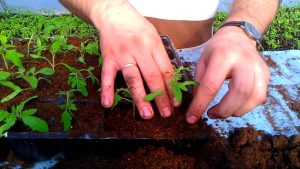 The temperature should be maintained at 22-24 ᵒC. In such conditions, tomatoes are kept for 3 days.
The temperature should be maintained at 22-24 ᵒC. In such conditions, tomatoes are kept for 3 days.
Opening the tomatoes you can see that not all of them feel good. The method does not regulate 100% survival rate, and 75% is a very good result.
Now we put the plants on the brightest place and lower the temperature to 18-20 ᵒC during the day and 14-16 ᵒC at night.
Stressed plants will sit for a long time in the ground. Further, they will begin to master the earthen clod of the root system and only then will they begin to grow. During this period, the stem will thicken, and those leaf plates that are to grow in size.
During the rooting period of landing it is necessary to provide:
- watering;
- airing;
- with light.
Airing is carried out by raising the cup. The first 2 weeks for a few seconds, then for a few minutes. As soon as we make sure that the plant started growing, the cups-greenhouses should be removed.
See also: The best varieties of tomatoes for open ground
If cultivation is carried out on window sills without additional lighting, the cups must be rotated daily. This procedure will ensure the evenness of the shoots. Since the Chinese way of planting a tomato implies that the seedlings should not be tall and stocky, one should not allow shoots to be pulled out, and for this one should jealously follow the uniform illumination of the shoots.
Transplant into the ground
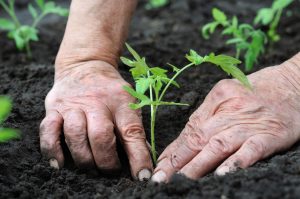 Seedling tomato in Chinese begins fruiting quickly. Given this, you should not hesitate with its landing in open ground. Tomato, a culture that does not tolerate frosts, so haste is also inappropriate.
Seedling tomato in Chinese begins fruiting quickly. Given this, you should not hesitate with its landing in open ground. Tomato, a culture that does not tolerate frosts, so haste is also inappropriate.
Choosing a place to land, should take into account predecessors. These can be any crops except tomatoes, peppers, and potatoes.
Cut tomatoes do not give much high shoots, but in any case they are tall, so you should provide a place protected from the wind.
If you are going to transplant, the day before the seedlings should be carefully watered. When carrying out work, it is necessary to monitor the integrity of the earthy coma and try not to destroy it when planting.
Sometimes, when the weather fails, and time is running out, planting such a seedling is carried out already with buds, and even flowers. There is nothing strange about it. As a rule, plants tolerate transplantation well, flowers are pollinated and an ovary is formed.
Top dressing
When doing the above-mentioned manipulations with a tomato plant, you need to take into account that a tomato will produce more brushes, and for this it will need more nutrients.
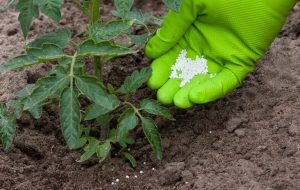 The first feeding is carried out in 1-1.5 weeks after disembarkation, and then weekly, alternating organic and mineral supplements.
The first feeding is carried out in 1-1.5 weeks after disembarkation, and then weekly, alternating organic and mineral supplements.
Since we no longer need the growth of the vegetative mass, and the plant entered the phase of budding and flowering, the nutrient solutions should be of the following composition:
- ammonium nitrate - 1 tbsp. spoon;
- potassium sulfate - 2 tbsp. spoons;
- superphosphate - 2 tbsp. spoons.
These mineral fertilizers are dissolved in 10 liters of water. Each planted tomato bush will need 0.5 liters of nutrient solution with a preliminary abundant watering of the plant.
Solutions of organic dressings are made from:
- chicken manure 0.5 kg per 10 liters of water;
- horse, pig, cow dung - 1 kg per 10 l of water;
- Rabbit, goat and sheep manure - 1 kg per 1 l of water (stand 2 days) then 9 l of water are added.
If the variety you choose is not resistant to diseases, then immediately after planting, the bushes need to be treated with fungicidal preparations. Further processing is repeated depending on weather and climatic conditions.
See also: Planting tomatoes in the greenhouse requires a competent approach
Choosing one or another method of cultivation, the vegetable grower must weigh the pros and cons and try the method on his own plot on his own, only this way one can understand the need and expediency of this agricultural technique.


 (7 ratings, average: 4,43 from 5)
(7 ratings, average: 4,43 from 5)